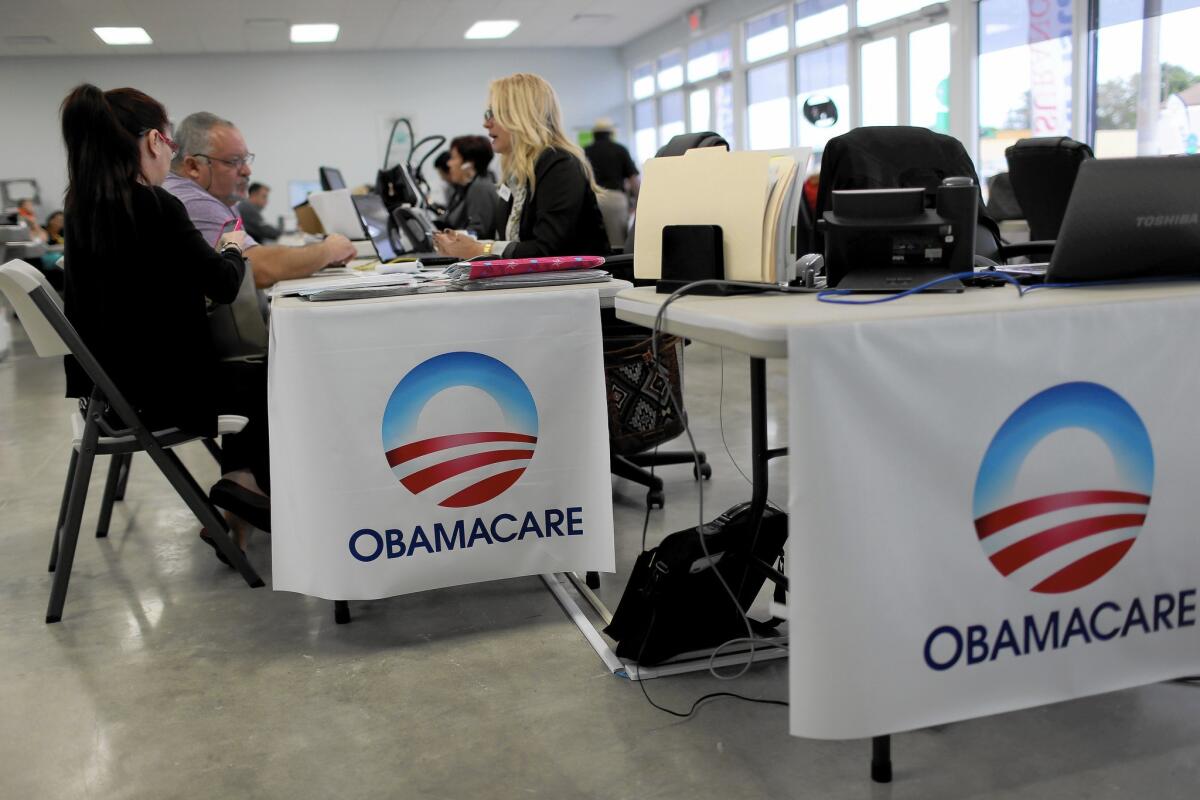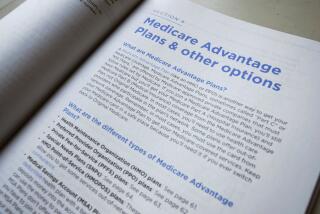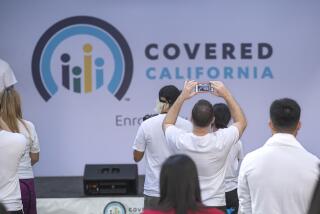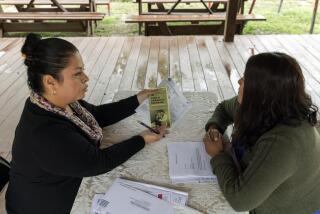Obamacare sign-ups expected to top 10 million amid sizable expansion

As the deadline for signing up for coverage through the Affordable Care Act approaches Sunday, enrollment in plans provided through the federal health law is on track to expand substantially over 2014.
Nationwide, preliminary tallies from state and federal health agencies suggest sign-ups should top 10 million and will probably go even higher in the final rush this weekend.
That total, though short of independent estimates that had projected 2015 enrollment at 13 million, still signals progress that will probably further drive down the nation’s already falling uninsured rate.
Eight million people signed up on marketplaces in 2014 (though the final enrollment tally last year was less than 6.7 million, as some consumers dropped plans or shifted to different coverage through the year and others were dropped because of immigration issues).
“Enrollment for 2015 showed strong growth,” said Dan Mendelson, chief executive of Avalere Health, a Washington consulting firm that closely tracks the health law. “This market is here to stay.”
The 2015 enrollment campaign — the second since insurance marketplaces created by the law debuted in 2013 — also has gone considerably more smoothly.
The federal HealthCare.gov website and similar state-based sites experienced no catastrophic meltdowns. Wait times at call centers around the country have been far shorter.
And marketplaces in states such as Hawaii, Maryland and Massachusetts, which barely functioned last year, have signed up tens of thousands of consumers since the current enrollment period began Nov. 15.
Despite the gains, coverage for millions remains in jeopardy, as the Supreme Court prepares to hear a challenge to the law’s system for providing government subsidies to offset consumers’ insurance premiums.
Back-end problems with data systems continue to make the enrollment process cumbersome for insurers. Some consumers may be facing stiff premium hikes if they automatically re-enrolled in their current plans, rather than selecting new, lower-priced options.
And with tens of millions of other Americans still uninsured, Obama administration officials and other proponents of the law are scrambling to get as many people as possible into health plans.
“We want those numbers to go higher,” Health and Human Services Secretary Sylvia M. Burwell told supporters at a medical ministry in North Carolina last week. “Once Feb. 15 comes, open enrollment is over and folks will have to wait until next year to enter into the system.”
In California, the push has taken on particular urgency as state officials try to hit an ambitious target of 1.7 million, about half a million more people than the final 2014 total.
The health law that President Obama signed five years ago allows Americans who don’t get health benefits at work to shop among plans on state-based marketplaces operated by the federal government or by the states themselves, including California, Connecticut and Maryland.
Consumers making less than four times the federal poverty level — or about $94,000 for a family of four — qualify for subsidies.
Insurers must provide a basic set of benefits and cannot turn away consumers, even if they are sick.
Enrollment in the marketplaces, although an imprecise metric, has been watched closely because sustained growth is key to reducing the number of uninsured and keeping premiums in check by getting healthier Americans into the market. Both are key goals of the health law.
Obama administration officials and many other backers of the law labored to downgrade expectations this year, noting that although millions of 2014 consumers would be automatically re-enrolled, reaching people who did not sign up the first year would be challenging.
In California, enrollment counselors and insurance agents said that despite fewer website glitches this year, there seemed to be less enthusiasm about the historic process.
“The slower rate of enrollment is a function of who is left out there,” said John Connolly, deputy director for Insure the Uninsured Project, a nonprofit research group in Santa Monica.
“The people who enrolled last year had more generous subsidies or really needed insurance because they had health conditions. The people who are left have to pay more and it’s a heavier lift to get them enrolled. There is a diminishing return effect.”
California state officials said that as of Feb. 2, 1.25 million people had purchased a health plan through Covered California, the state’s marketplace. That includes about 950,000 people who renewed their 2014 policies and nearly 300,000 new enrollees. Like HealthCare.gov, the California marketplace experienced attrition as enrollees switched to job-based coverage, moved to Medicaid or dropped out altogether.
Officials said more than 90% of existing policyholders renewed for this year, and they are hoping for another late surge of applicants similar to last year.
Elsewhere around the country, enrollment figures have been more encouraging, far surpassing last year’s totals.
In more than a dozen states, enrollment is more than 50% higher this year than last. In Wyoming, Oklahoma and Virginia, it is up nearly 60%, federal data show.
In Illinois, where local activists substantially expanded outreach efforts, more than 305,000 people have signed up for coverage through HealthCare.gov this year. That is up from about 217,000 last year, an increase of 40%.
Illinois was the first state to air an enrollment commercial featuring a gay couple. The state also debuted a tool to allow consumers to better compare health plans by calculating their total medical expenses, including premiums and out-of-pocket costs such as co-pays and deductibles.
In Florida, which like Illinois relies on HealthCare.gov, a major statewide enrollment effort also helped push up the tally there, already among the highest in the nation.
As of Friday, nearly 1.4 million people had picked a health plan, up from about 984,000 in the 2014 enrollment period.
“We clearly see that the need is high,” said Jodi Ray, project director for Florida Covering Kids & Families, which has been coordinating outreach efforts.
Like many activists, Ray expressed concern that many in Florida could lose coverage this year if the Supreme Court backs the legal challenge that would take away insurance subsidies from consumers in states like Florida that rely on the federal government to operate their marketplaces.
Other challenges remain as well. This tax season will mean penalties for potentially millions of Americans who did not get coverage last year as required under the law.
Kevin Counihan, who oversees the marketplaces at the Department of Health and Human Services, said recently that the agency is considering a special enrollment period after April 15 to allow these people to get coverage this year and avoid a second year of penalties.
Federal officials have declined to discuss those plans, stressing their focus on the current enrollment effort.
Twitter: @noamlevey, @chadterhune
Levey reported from Washington and Terhune from Los Angeles.








